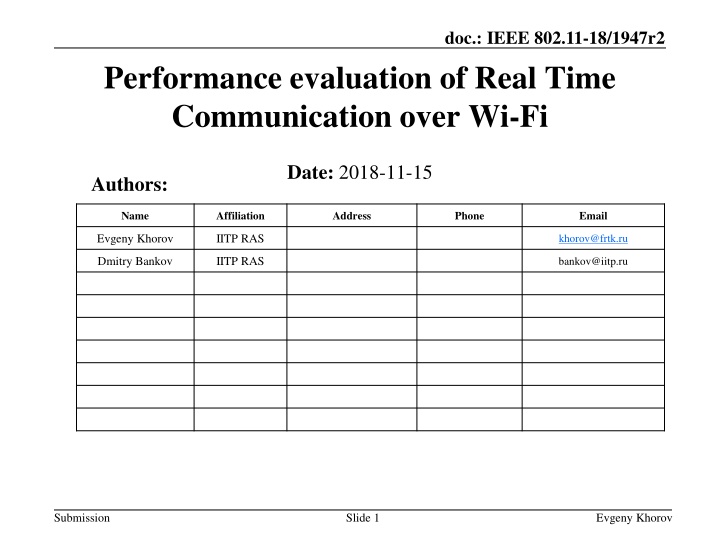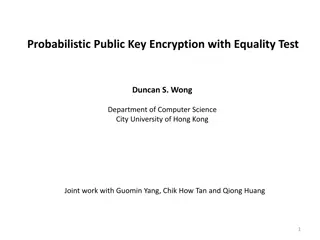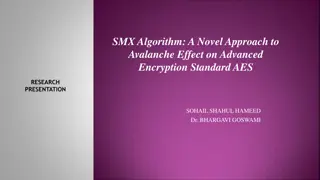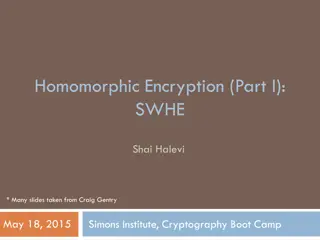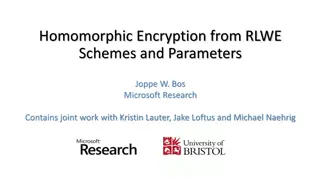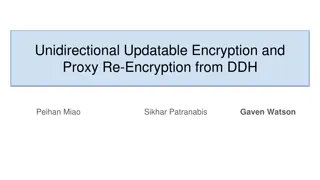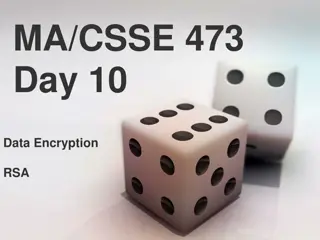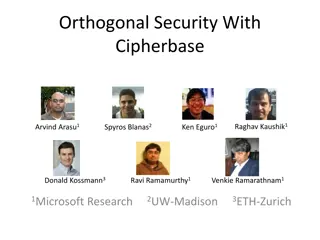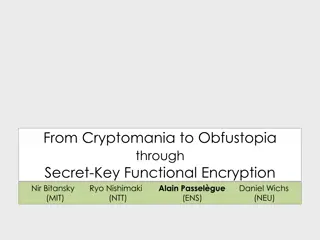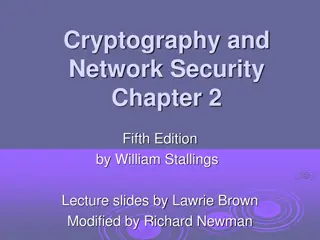Wireless Network Encryption Basics
Amidst an exploration of WEP and WPA-PSK security protocols, discover the fundamental aspects of basic encryption for wireless networks specified in IEEE 802.11-1997. Delve into the intricacies of WEP, including key lengths, encryption methods, and the significance of initialization vectors. Uncover the nuances of packet encryption, IV transmission, and key concatenation while understanding the vulnerable aspects of WEP security. Gain insights into the role of header, trailer, and ICV in protecting data integrity. Explore the operational principles of stream cipher and learn about the implications of poor key selection in wireless security.
Download Presentation

Please find below an Image/Link to download the presentation.
The content on the website is provided AS IS for your information and personal use only. It may not be sold, licensed, or shared on other websites without obtaining consent from the author.If you encounter any issues during the download, it is possible that the publisher has removed the file from their server.
You are allowed to download the files provided on this website for personal or commercial use, subject to the condition that they are used lawfully. All files are the property of their respective owners.
The content on the website is provided AS IS for your information and personal use only. It may not be sold, licensed, or shared on other websites without obtaining consent from the author.
E N D
Presentation Transcript
doc.: IEEE 802.11-18/1947r2 Performance evaluation of Real Time Communication over Wi-Fi Date: 2018-11-15 Authors: Name Affiliation Address Phone Email Evgeny Khorov IITP RAS khorov@frtk.ru Dmitry Bankov IITP RAS bankov@iitp.ru Submission Slide 1 Evgeny Khorov
Nov 2018 doc.: IEEE 802.11-18/1947r2 Outline 1. Preemptive Service 2. AX-like approach 3. Simulation results Submission Slide 2 Evgeny Khorov
Nov 2018 doc.: IEEE 802.11-18/1947r2 Preemptive service. Own RT packet Main idea: Stop transmitting a non-RT frame when a RT frame arrives. RT packet arrives in the queue of the same STA Data Time Ack Real Time Data SIFS Data Time [1] WTSN (Wi-Fi Time Sensitive Networking) doc.:IEEE 802.11-17/1734r1 Submission Slide 3 Evgeny Khorov
Nov 2018 doc.: IEEE 802.11-18/1947r2 Preemptive service. Alien transmission RT packet arrives in the queue of another STA Non-RT STA Data Data Channel is busy Time IFS SIFS Ack Data RT STA Time Busy tone in the service channel The RT STA generates busy tone in the service channel when it has an RT frame. Any ongoing transmissions should be cancelled. If no busy tone is in the service channel, the RT frame can be transmitted PIFS after the main channel becomes idle. Otherwise, RT frames contend for the channel access according to EDCA (high priority queue) [1] WTSN (Wi-Fi Time Sensitive Networking) doc.: IEEE 802.11-17/1734r1 Submission Slide 4 Evgeny Khorov
Nov 2018 doc.: IEEE 802.11-18/1947r2 AX-like approach Frequency RU m Other Transmissions MSBA TF TF RU 2 RU 1 Time SIFS SIFS Trigger Frame Multi Station Block-Ack Resource Units Assigned to specific STAs or Random Access (RA) Submission Slide 5 Evgeny Khorov
Nov 2018 doc.: IEEE 802.11-18/1947r2 AX-like approach. Possible Algorithm Frequency RU m RU m RU m M S B A M S B A M S B A T F T F T F RU 2 RU 2 RU 2 RU 1 RU 1 RU 1 Time RU 1 is for RT Random Access RU 2 m are used for usual DATA or RT DATA. RU duration is short enough to allow 3 TX within delay budget. Submission Slide 6 Evgeny Khorov
Nov 2018 doc.: IEEE 802.11-18/1947r2 AX-like approach. Possible Algorithm Non-RT RU RU m RU m STAs: m, 2m, STAs: m RT RA RU, idle STAs: 2m RT RU, idle RU 2 RU 2 STAs: 2, m+2 , STAs: m+2 RT RU, success RU 1 RU 1 STAs: 1, m+1, STAs: 2 RT RU Collision RU 0 RU 0 RU 0 RU 0 Time Apart from that, STA m+2 transmits. STAs 1, 2, m, 2m transmit RT frames By default, the AP allocates 1 RUs for random access In case of collision, the remaining m RUs are allocated for RA RT uniformly for those STAs, which might participate in the collision If the number of RT STAs is greater than m, each RU is allocated for several STAs Submission Slide 7 Evgeny Khorov
Nov 2018 doc.: IEEE 802.11-18/1947r2 Performance evaluation 1 AP, 10 non-RT STAs transmitting frames in saturated mode N RT STAs generate 32B frames (Poisson process with -1 = 50 ms) All STAs use MCS5 If a frame is not delivered within 1ms, it is dropped. Tdata= 0.9 ms (non-OFDMA), Trt= 0.06 ms, Period of RUs = 0,28ms, BW=40MHz, Nru=18 Portion of throughput for usual DATA Packet loss ratio (both collisions and drops) Submission Slide 8 Evgeny Khorov
